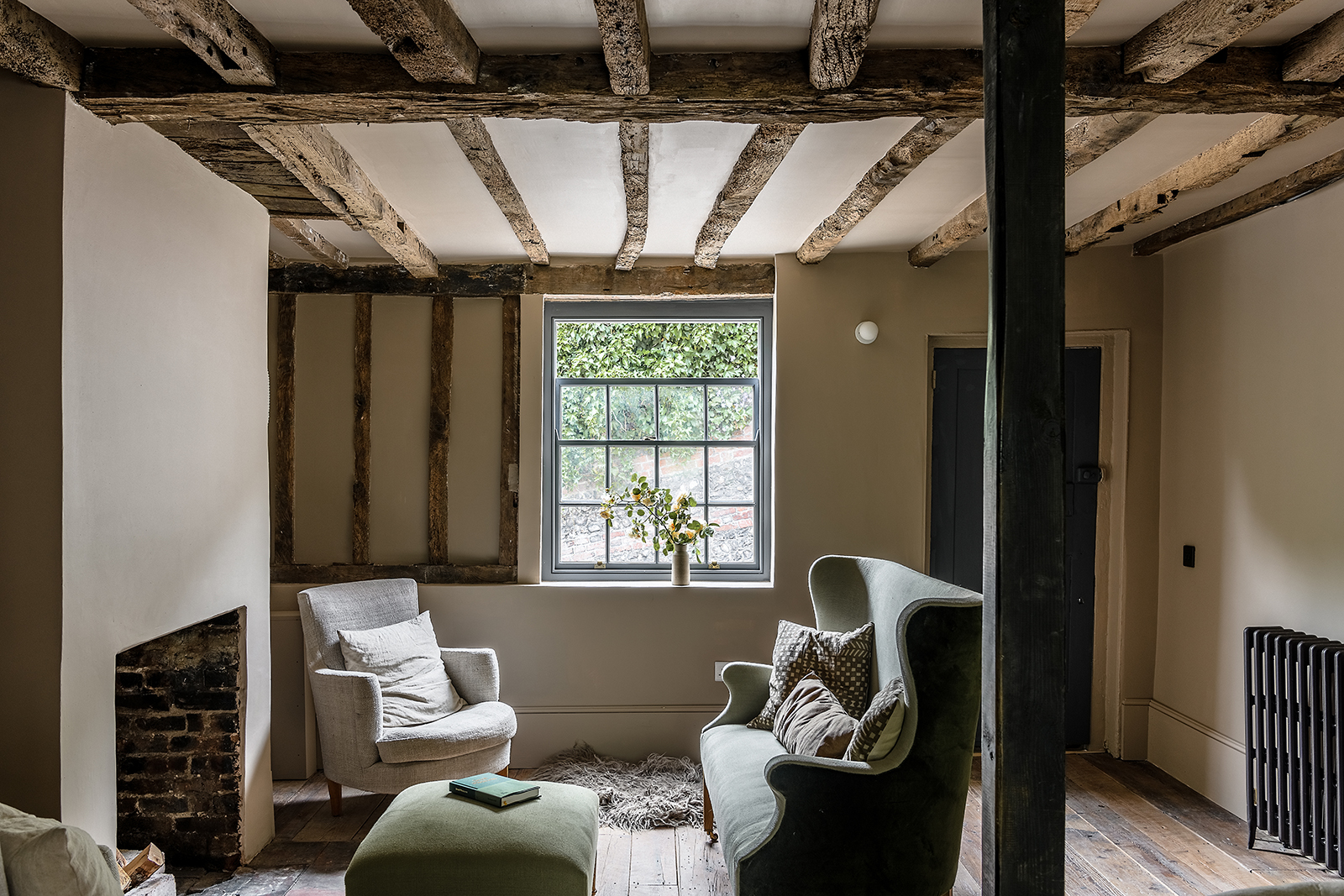The Grand Tour
The entrance opens immediately to the main living area, a beautiful open room with untreated pitch pine floorboards underfoot. There is a palpable sense of serenity, with spare detailing and carefully considered spaces for lighting and treasured objects. An open hearth with a working fire lends a sense of warmth to the room, as do the bare timber columns and beams. Walls are washed throughout the house in the quiet, natural shades of paint from
Atelier Ellis. The intense pigments create an extraordinary atmosphere, with subtle changes in colour playing with the light from room to room, lending an almost wabi-sabi quality to the house.
The kitchen and dining room lie to the rear of the plan, with a pale grey concrete floor unifying both rooms. The simple cabinetry has been painted in ‘
Solstice’, and concealed appliances discreetly housed below sycamore worktops with a natural waney edge. The room is flooded with light care of two glass apertures high above. The dining room is a wonderfully versatile space, acting as a continuation of the kitchen but also distinctly separate. There are multiple box sash windows and a glass door leading to the garden, which frames views onto the verdant raised beds and shrubbery.
A wooden staircase ascends to a living room painted in the rich, atmospheric ‘
Plume’. Original cupboards rest in alcoves either side of a Georgian chimney piece with a Victorian cast-iron insert (a later addition). A secondary bedroom can be found to the rear of this floor next to the bathroom; this space has a wonderful quality of light, with a beautiful copper bateau tub at its centre and stunning brassware.
The main bedroom is housed in the garret at the apex of the house; a peaceful room with bare elm floorboards underfoot crowned by a pitched roof with blackened beams. Sash windows at both aspects frame incredible views down to Southover Grange Gardens, Lewes Priory and the dramatic Firle Beacons in the distance.
The Great Outdoors
Entered from the dining room with additional separate side access, the tiered garden is wonderfully positioned to enjoy the sun throughout the day. The different levels have been carefully planted with a selection of shrubs, flowers and grasses including hydrangeas, foxgloves, fennel and irises, while a mature Medlar tree is positioned in prime position on the uppermost tier. A central circular brick-paved terrace provides the perfect spot for alfresco lunches in warmer months.
Flint walls surround the garden; the old town wall of Lewes is positioned to the rear, behind a wooden Japanese teahouse – a remnant from a previous inhabitant who was a practicing Zen master.
For adventures in nature further afield, Lewes is nestled in The South Downs National Park. There are many beautiful walks across the surrounding landscape including The South Downs Way, which takes a spectacular coastal route over the Seven Sisters to Beachy Head, leading all the way to the sea.
Out and About
Lewes has a history dating to pre-Saxon times, being an immensely important strategic point thanks to its position on the slopes either side of the Ouse Valley. A Roman settlement is believed to have been positioned on the site, followed by Anglo-Saxon and Anglo-Norman settlements, until around the 6th century when the town itself was founded.
There is much to do in Lewes itself, which is home to plenty of independent shops, antiquarian bookshops and a number of antique markets. There are numerous cafes, such as
Patisserie Lewes and
Flint Owl Bakery, and galleries including
The Star Brewery Gallery and
The Needlemakers Craft Centre. There are also many independent businesses that stock work by local craftspeople.
Glyndebourne Opera House is only a few miles away, and special coaches are laid on at Lewes Station during the season. There is a new cinema and art complex,
The Depot, which shows a variety of mainstream and arthouse movies. For a wider range of amenities Brighton is also close by – only 10 minutes by train – with its countless restaurants, shops and cafes.
Lewes is known for its Bonfire Night, which it hosts annually on November 5th. It is a spectacle like no other; with a large costumed parade comprised of various bonfire societies that wind their way through the town to their separate bonfires.
Lewes railway station has direct services to London in around 63 minutes and Clapham Junction in under an hour. There are also direct services to Gatwick Airport that take approximately 31 minutes. Lewes is on the A27, which connects with the A23 London to Brighton road.
